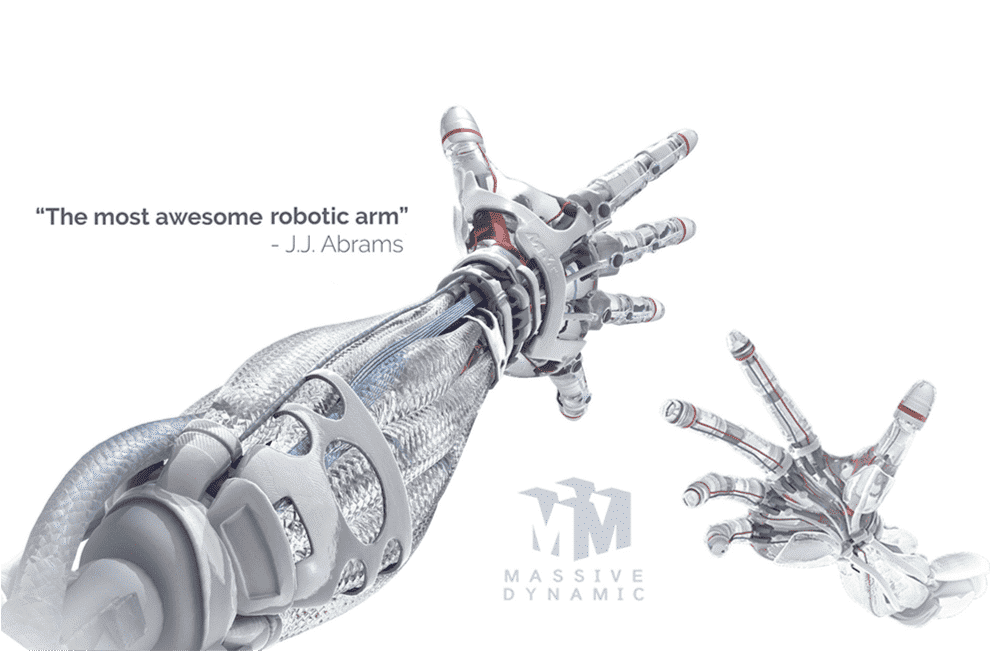THE PROJECT
Fringe was a prime-time science fiction television series created by J. J. Abrams. The story centers around the Fringe Division of the FBI that is investigating bizarre and often dangerous occurrences that bridge to a parallel universe.
THE CHALLENGE
Having lost her right arm when an inter-dimensional portal closed, the character Nina has an extremely high-tech prosthetic arm that functions as fluidly as a real arm. The challenge was to create a concept design of a biomechanical prosthetic arm that was both visually captivating and seamlessly integrated into the live-action footage.

THE SOLUTION
- Concept Design Process
After reading the script, the concept designer collected visual references for inspiration. The sketches started out as rough ideas to set a direction before being refined into more detailed drawings. Working closely with the art director and producer, the designer created multiple variations to explore different options.
3D Modeling the Arm Components
The visual effects artists began the process by using 3D software to model the bones, wires, and muscles of Nina’s prosthetic arm. This step involved designing each component with precision to ensure a realistic and visually captivating result.
3D Surface Materials Development and Lighting
Once the arm components were modeled, surface materials were developed to give the arm a realistic texture and appearance. The scene was then colored and lit in a way that made the computer-generated elements look realistic and consistent with the live-action footage.
3D Motion Capture and Animation
To animate the prosthetic arm, the visual effects team used motion capture technology to record the actor’s arm movements. This data was then applied to the computer-generated elements, ensuring that the prosthetic arm’s movements matched the actor’s performance.
3D Separating and Rendering Elements
The last step in the 3D software process was to separate elements like reflection, refraction, shade, and shadow. These elements were then rendered as separate layers, providing greater control over the final appearance during the compositing stage.
2D Image Compositing with Live Footage
The output from the 3D software was a series of 2D image renders, which were then composited together with the live-action footage. This process involved carefully aligning and blending the computer-generated elements with the live footage, ensuring a seamless integration. The combination of 3D modeling, animation, rendering, and compositing techniques resulted in a visually dynamic prosthetic arm that appeared both lifelike and captivating on screen.
Seamless Integration into Live-Action Shot
The attention to detail and careful blending of the 2D image renders with the live footage allowed for a seamless integration of Nina’s prosthetic arm into the live-action shot, contributing to the show’s immersive storytelling and captivating visuals.
Visual Effects: Starting in 3D software, the bones, wires, and muscles of the arm are modeled. Next, surface materials are developed and the scene is colored and lit to make the computer-generated elements look realistic. From the live-action footage, the actor’s arm is motion captured and the computer-generated elements are animated to match. The last step in the 3D software is to separate elements like reflection, refraction, shade, and shadow and render the layers. The output is 2D image renders that are composited together with the live footage to create a final sequence. The result is both visually dynamic and seamlessly integrated into the live-action shot.

This project included:
- Concept Design
- Visual Effects
THE OUTCOME
J.J. Abrams
The biomechanical prosthetic arm design garnered high praise from the show’s creator, J.J. Abrams, who is known for his visually striking projects and innovative storytelling. In his script note, Abrams lauded the design, referring to it as “the most awesome robotic arm.”
Fan Reception
The design also resonated with the show’s rabid fan base, who appreciated the attention to detail and the seamless integration of the prosthetic arm into the live-action scenes.
What KAIA can do for you
Discover the power of visualization; collaborate across disciplines and captivate clients. Photorealistic visualization can achieve better design outcomes, more effective communication, informed decision-making, and overall improved project management. Highly detailed and accurate representation of your engineering projects can help you identify potential issues early in the development process, ensuring the most realistic and efficient solutions possible.


